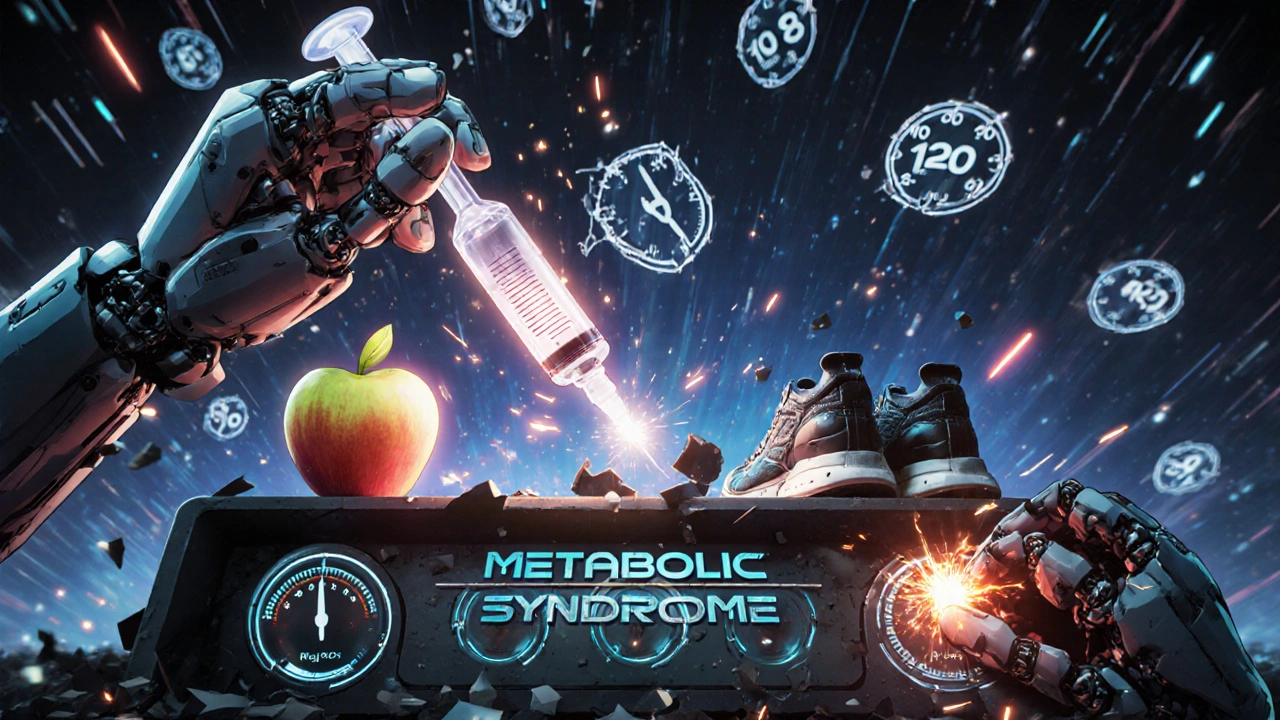Imagine your body is a car. One warning light comes on - maybe the oil pressure. You fix that. But what if five lights are blinking at once? Oil, temperature, battery, fuel, and brake fluid all low? That’s not just a series of problems. That’s a system failure. Metabolic syndrome is exactly that - five warning signs flashing together, telling your body it’s on the brink of heart disease, stroke, or type 2 diabetes. And most people don’t even know it’s happening.
What Exactly Is Metabolic Syndrome?
Metabolic syndrome isn’t one disease. It’s a cluster of five specific health problems that often show up together. You don’t need all five to be in danger - just three. And if you have three, your risk of heart disease jumps by 1.5 to 2 times. Your chance of developing type 2 diabetes? It skyrockets by five times.
The five markers are clear, measurable, and simple to check:
- Abdominal obesity: Waist size over 40 inches (102 cm) for men, or 35 inches (88 cm) for women. For Asian populations, the thresholds are lower - 35 inches for men, 31 inches for women.
- High triglycerides: 150 mg/dL or higher. These are fat particles in your blood that can clog arteries.
- Low HDL cholesterol: Under 40 mg/dL for men, under 50 mg/dL for women. HDL is the "good" cholesterol that helps clean out your arteries.
- High blood pressure: 130/85 mmHg or higher. Even if it’s just one number, it counts.
- Elevated fasting blood sugar: 100 mg/dL or higher. This is your body’s first red flag that insulin isn’t working right.
These numbers aren’t arbitrary. They come from decades of research by the American Heart Association, the National Heart, Lung, and Blood Institute, and the International Diabetes Federation. If you hit three of these, you’re not just "a little out of shape." You’re in a high-risk zone.
Why Insulin Resistance Is the Root Cause
Underneath all five of these markers is one silent driver: insulin resistance. This isn’t just about sugar. It’s about how your cells respond - or don’t respond - to insulin, the hormone that shuttles glucose into muscle and fat cells for energy.
When your cells stop listening to insulin, your pancreas pumps out more and more to compensate. That’s called hyperinsulinemia. Over time, this floods your body with excess insulin, which directly raises blood pressure, increases fat storage around your belly, and messes with your liver’s ability to manage cholesterol and triglycerides.
That’s why abdominal fat is so dangerous. Unlike fat under the skin, visceral fat - the kind wrapped around your organs - is metabolically active. It releases inflammatory chemicals and free fatty acids that make insulin resistance worse. It’s not just a symptom. It’s the engine driving the whole syndrome.
Doctors used to debate whether metabolic syndrome was even a real condition. Some argued it was just a collection of unrelated risks. But the evidence is clear now: treating one piece - say, lowering blood pressure with medication - doesn’t fix the core problem. Only addressing insulin resistance through lifestyle changes can truly reverse the pattern.
Who’s Most at Risk?
Metabolic syndrome doesn’t pick favorites - but it does favor certain patterns.
In the U.S., about 35% of adults have it. That’s over 85 million people. The risk climbs sharply with age: 20% in your 20s and 30s, jumping to nearly 50% by age 60. But it’s not just older people. More and more teenagers and young adults are showing up with waistlines and blood sugar levels that scream metabolic syndrome.
There are also stark ethnic differences. Hispanics have the highest rates at nearly 39%, followed by non-Hispanic whites at 34%, non-Hispanic Blacks at 32%, and non-Hispanic Asians at 24%. Why? Genetics play a role, but so does access to healthy food, physical activity opportunities, and healthcare.
People with polycystic ovary syndrome (PCOS) are especially vulnerable. Hormonal imbalances in PCOS directly worsen insulin resistance. Many women with PCOS develop metabolic syndrome without even being overweight - a sign that this isn’t just about calories in and out.
And it’s not just an American problem. Globally, prevalence is rising fast. By 2030, nearly 40% of adults worldwide could have it - with the sharpest increases in South Asia and Latin America, where diets are shifting toward processed foods and sedentary lifestyles are becoming the norm.

Why Most People Don’t Know They Have It
Here’s the scary part: most people with metabolic syndrome don’t know it.
On patient forums like HealthUnlocked, 68% of users said their doctor never told them they had the syndrome - even though they had high blood pressure, high triglycerides, and a large waist. Doctors often treat each number separately: "Your blood pressure is high, here’s a pill." Or, "Your cholesterol’s off, let’s start a statin." But they rarely connect the dots.
It’s like fixing a leaky faucet while ignoring the cracked pipe underneath. You’re treating symptoms, not the cause.
Reddit users in r/MetabolicSyndrome report similar frustrations. One common theme: "I lost weight, felt better, but my doctor didn’t say I had metabolic syndrome. I only found out after I did my own research."
And here’s the worst part - many people feel fine. No chest pain. No dizziness. No obvious signs. That’s why metabolic syndrome is called a silent killer. It doesn’t hurt until it’s too late.
How to Reverse It - Without Medication
The good news? You can reverse metabolic syndrome - and many people have.
The landmark Diabetes Prevention Program showed that losing just 7% of your body weight - say, 15 pounds if you weigh 215 - and exercising 150 minutes a week (that’s 30 minutes, five days a week) cuts your risk of developing type 2 diabetes by 58%. It also reduces waist size, lowers blood pressure, improves cholesterol, and brings blood sugar back to normal.
It’s not about extreme diets or punishing workouts. It’s about consistency:
- Move daily: Brisk walking counts. Gardening, dancing, cycling - anything that gets your heart up for 30 minutes.
- Eat real food: Cut out sugary drinks, white bread, pastries, and fried foods. Focus on vegetables, beans, whole grains, lean proteins, nuts, and healthy fats like olive oil and avocado.
- Stop eating late: Eating after 8 p.m. disrupts your body’s natural rhythm and worsens insulin resistance.
- Sleep 7-8 hours: Poor sleep increases cortisol, which drives belly fat and insulin resistance.
One man in Bristol, 56, had all five markers. He lost 22 pounds in six months by walking every morning, swapping soda for sparkling water, and cooking at home. Within a year, his triglycerides dropped from 210 to 98. His blood pressure normalized. His fasting glucose fell to 86. He didn’t take a single new pill.

When Medication Might Help - But Isn’t the Answer
There’s no drug approved specifically to treat metabolic syndrome as a whole. That’s intentional. Because drugs don’t fix insulin resistance. They mask symptoms.
Doctors might prescribe:
- Statins for high cholesterol
- ACE inhibitors or beta-blockers for high blood pressure
- Metformin to lower blood sugar
These help - but they don’t reverse the syndrome. And they come with side effects: muscle pain, digestive issues, fatigue.
The American College of Cardiology now recommends that people with metabolic syndrome start statins earlier - not because they’re a cure, but because their overall risk is so high. But even then, lifestyle change is still the foundation.
The New Tools Making a Difference
Technology is finally catching up. In January 2023, the FDA approved the first digital therapeutic for metabolic syndrome: DarioHealth’s Metabolic+ app. It uses continuous glucose monitoring - a tiny sensor on your arm that tracks your blood sugar 24/7 - paired with personalized coaching.
In a clinical trial, users saw their HbA1c (a measure of long-term blood sugar) drop by 0.6% and their waist size shrink by over 3 cm in just six months. That’s not just a number - it’s real change in how their body functions.
Other programs, like the Mayo Clinic’s Integrated Metabolic Syndrome Program, use teams: dietitians, exercise physiologists, behavioral therapists. In their 2021 report, 68% of participants reversed the syndrome within a year.
Community health workers - people from the same neighborhoods, trained to support lifestyle changes - are also proving effective. In one CDC-backed program, Hispanic participants working with lay health educators lost more weight than those in standard care.
The Big Picture: A Preventable Crisis
Metabolic syndrome costs the U.S. over $360 billion a year - $219 billion in medical bills, $143 billion in lost work. It’s the leading preventable cause of type 2 diabetes, responsible for 75-80% of new cases.
But here’s the most powerful fact: the DiRECT trial showed that 46% of people with type 2 diabetes and metabolic syndrome went into full remission after losing 15 kilograms (33 pounds) or more through intensive weight management. That’s not a miracle. That’s science.
It means your body isn’t broken. It’s just overwhelmed. Give it the right signals - food that heals, movement that energizes, sleep that restores - and it can heal itself.
Metabolic syndrome isn’t a life sentence. It’s a wake-up call. And the best part? You don’t need a doctor’s permission to start fixing it.
Can you have metabolic syndrome without being overweight?
Yes. While abdominal obesity is one of the five key markers, some people - especially those with PCOS or certain genetic backgrounds - develop insulin resistance and the other metabolic markers even at a normal weight. Blood sugar, triglycerides, HDL, and blood pressure can still be out of range. Waist measurement is the most reliable indicator, not body weight alone.
Does metabolic syndrome always lead to diabetes?
No, but it greatly increases the risk. People with metabolic syndrome are five times more likely to develop type 2 diabetes than those without it. But studies show that losing 5-7% of body weight and exercising regularly can cut that risk by more than half. Reversing metabolic syndrome means preventing diabetes before it starts.
Is metabolic syndrome the same as prediabetes?
No. Prediabetes means your blood sugar is higher than normal but not yet diabetic. Metabolic syndrome includes prediabetes as one of its five components - but it also adds high blood pressure, abnormal cholesterol, and abdominal fat. You can have prediabetes without metabolic syndrome, but if you have metabolic syndrome, you almost always have prediabetes.
Can children get metabolic syndrome?
Yes - and it’s rising fast. With childhood obesity rates climbing, more teens are showing signs: high blood pressure, fatty liver, elevated blood sugar, and large waistlines. The American Academy of Pediatrics now recommends screening for metabolic syndrome in overweight children starting at age 10, especially if there’s a family history of diabetes or heart disease.
Why don’t more doctors screen for it?
Many doctors still treat each risk factor separately - high BP here, high cholesterol there - without seeing the bigger pattern. Insurance doesn’t always cover comprehensive lifestyle programs, so there’s little incentive to spend time on prevention. But awareness is growing. The American Heart Association now recommends screening for metabolic syndrome in adults with obesity or a family history of diabetes.
How long does it take to reverse metabolic syndrome?
Many people see improvements in as little as 3 months. Blood pressure and triglycerides often drop quickly with dietary changes. Waist size and blood sugar take longer - usually 6 to 12 months of consistent effort. Studies show that 12 months of lifestyle change leads to full reversal in up to 70% of cases, especially when support from dietitians or health coaches is included.



JD Mette
November 22, 2025 AT 23:50It’s wild how many people walk around with three of these markers and think they’re fine because they don’t feel sick. I had high triglycerides and borderline blood pressure for years-no symptoms, so I ignored it. Then my dad had a stroke at 58. That woke me up. Started walking daily, cut out soda, and within six months, everything improved. No meds needed.
Olanrewaju Jeph
November 23, 2025 AT 14:27Excellent breakdown. The insulin resistance explanation is particularly accurate. In Nigeria, we see this rising fast among urban youth who consume processed foods and sugary drinks daily. Many believe being thin means they’re healthy-this is a dangerous myth. Waist circumference matters more than BMI.
Dalton Adams
November 24, 2025 AT 03:07Let’s be real-this isn’t rocket science. If you’re eating like a college freshman who just discovered McDonald’s, of course you’re going to develop metabolic syndrome. The fact that people still don’t get it is embarrassing. You don’t need a PhD to know that soda + fries + no sleep = disaster. The real issue? Denial. And doctors who treat numbers instead of people.
Also, the DarioHealth app? Cute. But if you can’t afford fresh produce or a gym membership, an app won’t save you. This is a socioeconomic crisis wrapped in a medical label. Stop blaming individuals and fix the food deserts first.
Kane Ren
November 24, 2025 AT 14:54I was told I had prediabetes at 32. I thought I was doomed. But I started cooking one new veggie recipe a week, took the stairs, and slept like my life depended on it-because it did. Two years later, my numbers are normal. It’s not magic. It’s consistency. You don’t have to be perfect. Just show up. Your body remembers every good choice.
Charmaine Barcelon
November 25, 2025 AT 23:34Okay, so let me get this straight… you’re saying if you eat junk, don’t move, and sleep poorly, you’ll get sick? Shocking. And people wonder why healthcare is so expensive? It’s because they refuse to do the bare minimum. Just stop eating sugar. Just walk. Just sleep. It’s not hard. It’s just easier to blame the system.
Karla Morales
November 26, 2025 AT 09:53📊 Data point: 68% of Reddit users in r/MetabolicSyndrome reported discovering their condition through self-research-not clinical screening. This is a systemic failure. Healthcare is reactive, not preventive. We’re treating symptoms like they’re isolated events, not red flags in a cascading failure. The WHO estimates that 80% of type 2 diabetes is preventable. We’re not just failing patients-we’re failing public health infrastructure. 🚨
Javier Rain
November 27, 2025 AT 23:23I’ve seen this firsthand. My cousin, 47, had all five markers. Doctor gave him a statin and a blood pressure pill. He was depressed, tired, and felt like a broken machine. Then he joined a community walking group. Lost 30 pounds. Stopped all meds. Said he finally felt like himself again. This isn’t about willpower-it’s about community. We need more of these programs. Not just apps. Real people, real support.
Laurie Sala
November 28, 2025 AT 22:09I’ve been diagnosed with PCOS since I was 19… and I’ve never been overweight. But my blood sugar? Always creeping up. My triglycerides? Always high. My doctor never connected the dots until I cried in his office and said, "I’m tired of feeling like I’m dying slowly." He finally ordered the full panel. That’s when I found out: I had metabolic syndrome. No belly fat. Just broken insulin. And no one told me. No one cared. Until I screamed.
Lisa Detanna
November 30, 2025 AT 15:58In my community in Chicago, we started a "Cook & Walk" program with local churches and corner stores. We swapped fried chicken for baked tofu bowls. Walked after dinner together. No one was shamed. No one was lectured. Just food, movement, and connection. Within a year, 14 out of 20 participants reversed their metabolic syndrome. It’s not about perfection. It’s about belonging.
Demi-Louise Brown
December 2, 2025 AT 13:01The DiRECT trial results are compelling. Remission is possible. But access is unequal. Those with resources, education, and time succeed. Those without? They’re left with pills and guilt. We need policy change: subsidies for fresh food, paid time for wellness, insurance coverage for lifestyle coaching. Medicine can’t heal what society breaks.
Matthew Mahar
December 2, 2025 AT 14:10wait so if you have all 5 you're basically a walking time bomb?? like... holy crap i think i have like 4 of these?? i'm 28 and my waist is 38 and my triglycerides were 180 last year and i sleep 5 hours... i think i need to change something. like yesterday. 🙏